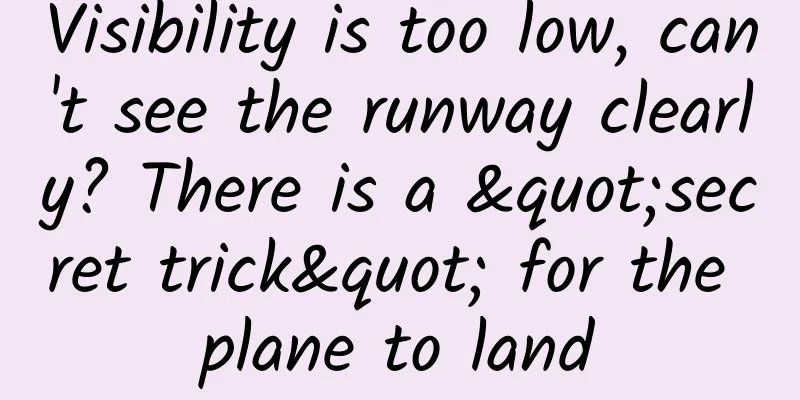Visibility is too low, can't see the runway clearly? There is a "secret trick" for the plane to land

|
On a calm night, a gentle breeze blew quietly over the airport. Behind the calm, there are constantly changing meteorological elements. The temperature gradually dropped and the relative humidity rose rapidly, which was the precursor of heavy fog. Near the morning, the observer looked at the runway and saw that the airport was covered with fog. At this time, the first inbound flight of the morning was approaching the airport, gradually approaching the thick fog covering the airport. How does an airplane land in low visibility? Before commanding an airplane to fly into a foggy area, you must first understand how the approach and landing process is different from that in normal times: an airplane landing in foggy weather is like a car driving on a highway in foggy weather. Looking forward, the road is swallowed by thick white fog. The runway that you can usually see clearly from a distance can only be seen with a few faint lights. You can imagine how difficult it is to continue flying in the vast whiteness. However, advanced aircraft will not be scared away by this ordinary fog. Unlike driving a car, which can only rely on the naked eye, the aircraft has invisible eyes to guide its flight. To know how low visibility affects the landing of an aircraft, let's follow this plane that is about to land to find out. After the plane begins its approach, two problems must be solved in order to land successfully: aligning with the centerline of the runway and lowering the altitude at an appropriate rate to land at the runway entrance. The two define invisible air roads for each landing aircraft: the localizer and the glide path. The communication and navigation equipment on the aircraft and on the ground cooperate with each other to guide the left and right height deviations of the aircraft during the approach. In this process, the pilot can completely get rid of the influence of "invisibility" on himself, and fly the aircraft on approach under the guidance of the precision approach navigation equipment. This is the legendary "blind landing". Seeing that the first flight was about to approach the runway, we pressed the pause button. Although the aircraft can make a blind landing without relying on visual sight during the approach process, in the final stage of landing, the pilot still needs to visually observe the runway and manually control the aircraft to complete the final landing. Smart readers may think that it would be great if they could tell the pilot what altitude to descend to and how far away from the runway he can see the airport runway before landing. However, observers on the ground cannot grow a pair of wings, so they can only think from the perspective of others and provide the crew with the most appropriate visibility value on the ground. Runway visual range (RVR) is the most valuable reference value among many visibility values in low visibility operation. Compared with the human eye to judge the horizontal visibility distance around the airport area, the visibility required by the pilot is higher and more detailed: I don’t care what the average visibility of the entire airport is; you just need to tell me what the visibility is in front of the aircraft facing the runway. The runway visual range is a pioneer who can think in this way, facing the runway in the touchdown zone, and it reflects the precise visibility value along the runway. Do you remember comparing airplanes in foggy weather to cars on the highway? In fact, compared to car drivers who can only rely on themselves to control the steering wheel when they get on the highway in foggy weather, airplane pilots with the help of precision approach navigation are like being instructed by traffic police standing on the roadside in real time about the speed and direction to drive on the road. In the past, when encountering low visibility weather, the aircraft only had altitude information, and the navigation information was not very precise. The aircraft had to switch to visual manual operation by the crew from a long distance, which put forward very high requirements on visibility. Now, with the increasingly advanced navigation facilities, the precision approach radar on the ground can determine the position of the aircraft at a high frequency, and report the deviation in heading and altitude and the runway distance to the pilot in a timely and accurate manner, ensuring that the aircraft approaches and lands on the predetermined glide path. From then on, there is no need to search for the target in the vast fog, but the instrument landing system lights up the lighthouse at the target to mark the expected route. With the continuous upgrading of the instrument landing system, the landing conditions of the aircraft in low visibility weather are also constantly improving. In recent years, with the popularization of Category II precision approaches, aircraft can already land when the runway visibility is 300 meters. In the future, with the approval of the use of more advanced Category III precision approaches, aircraft will even be able to break free from the constraints of low visibility and take off and land freely when visibility is zero. Readers may ask questions after reading this. We have been discussing the process of landing an aircraft in low visibility, but no one said that low visibility only occurs in foggy weather. Indeed, in addition to foggy weather, snowy weather, sandstorms, and other windy and sandy weather can also cause low visibility. However, our precision navigation equipment and visibility detection equipment will not be affected by different weather types. They will consistently provide safe and reliable guidance for aircraft in the sky. In a blink of an eye, the plane full of passengers landed smoothly in the fog. The planes waiting to take off on the taxiway have also lined up neatly, and the airport has once again returned to its former busyness. With the increasing advancement of aircraft performance, navigation equipment, and meteorological detection equipment, our air traffic control support capabilities have also become stronger and stronger, able to cope with all kinds of complex weather, while ensuring flight safety, and providing passengers with a more comfortable and convenient travel experience. |
<<: Safe screen usage distance! You don’t even know these key values?
>>: What is the best way to quench your thirst in summer? Not iced cola, not water, but...
Recommend
Tencent Guangdiantong advertising optimization strategy!
In the 2020s, is there still anyone who doesn’t k...
Jose Data Spark + Flink Full Stack Training Camp Advanced Class
: : : : : : : : : : : : : : : : : : : : : : : : : ...
Introduction to Baidu information flow promotion white paper! (Attached with download)
As user behavior undergoes tremendous changes in ...
Explosive materials and landing pages for popular industries!
The more exaggerated, the more explosive? Totally...
Have a healthy new year! Let’s check the “small hidden dangers” in the refrigerator first
During the Chinese New Year, many families have t...
How to overcome height anxiety? You don’t really need to rely on height-increasing injections →
Everyone wants to have long legs and be tall, but...
Methods and key points for operating and promoting online activities!
I think the most important thing in the process o...
Video account sales bonus project, complete tutorial from getting started to placing orders
Video account sales bonus project, complete tutor...
Second-tier e-commerce ▏ Douyin Luban hot-selling product category launch summary!
Information flow platforms all have popular produ...
Experience Post: Thoughts on Regional APP or WeChat Public Account Promotion
Regional promotion can also be understood as grou...
The latest Google Admob channel promotion strategy in 2015
According to statistics, taking Android as an exam...
How to build an event operation and promotion framework in 4 steps?
We often see various commercial activities: Tmall...
Sleeping restlessly, always kicking and punching? Be careful, you may have this disease...
Reviewer of this article: Chen Haixu, Deputy Dire...
A Beginner's Guide to Brand Building
Brand building is a very difficult, lengthy and a...
Is it safe to eat the Basa fish that costs only a few dollars a bag in the supermarket?
Have you noticed that restaurants love to use Bas...
![[Popular Science] Why are many quadruped robots designed to look like dogs?](/upload/images/67f223b21c585.webp)








